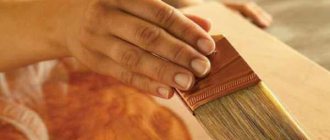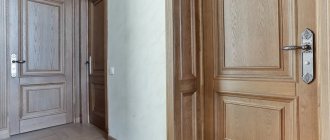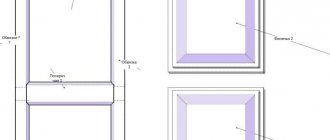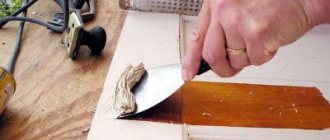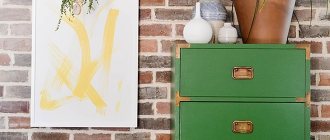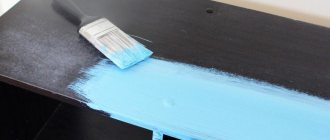Thanks to modern technologies, today wooden doors not only look beautiful, but are also of high quality, which is difficult not to pay attention to.
But not everyone can afford to decorate their premises with high-quality doors, because such a product made from natural wood species costs a lot of money. But, as a budget option, you can purchase a “semi-finished product” - a door made of solid wood, for example oak, wengue or pine (usually sold in standard sizes), without decorative elements, and give the door leaf an original design with your own hands, painting the wood in the most suitable way LMB.
Unfortunately, buying a new interior door block is more problematic for owners of apartments with an old layout, because the “original” doors have non-standard sizes. In this case, you will have to make doors to order, which will cost a pretty penny. Therefore, it makes sense to restore old doors, thereby saving the family budget and making the apartment unique and unique.
Next, we will tell you how to properly prepare the surface, in what sequence the painting work should be carried out and what paint to paint a wooden door so that the final result looks not only good, but also unusual, if the style of the room requires it.
Choosing paint and varnish for interior doors
An old wooden door that has lost its attractiveness can be easily restored by painting. To give the canvas a truly new look, you need to choose the right paint and do the preparatory work. Painting compositions based on aggressive solvents are a thing of the past. An excellent choice for painting a door block is odorless enamel, stain or water-based varnish.
What to consider when choosing paint?
Having decided to independently restore interior wooden doors, you need to learn an important rule: odorless paint is intended for interior work, and all other enamels and varnishes are for external use.
When choosing enamel for windows and doors, take into account the characteristics of the canvas:
- The door block is made from different types of wood and waste from the woodworking industry. The density of the material determines the amount of paint absorption before it dries. An extra layer is an additional cost. When choosing an expensive paint and varnish material, it is wise to use drying oil. After impregnation, loose wood will be covered with a film, and paint absorption will decrease.
- The consumption of varnish or enamel for doors depends on the surface. For a smooth one, just apply two thin coats of paint. Rough material requires more layers.
- When restoring door blocks, it will not be possible to completely remove the previous coating. The new paint and varnish material should not contain aggressive substances that corrode the old paint. During the reaction, swelling and peeling will appear on the canvas.
Additionally, when choosing a paint and varnish material, the intensity of use of the door block, as well as the level of humidity and ambient temperature
The choice of color is a personal preference. The new canvas looks beautiful under clear varnish or with the addition of stain. After cleaning, it is better to cover the old door with enamel, choosing the desired color.
Frequent changes to the interior are not complete without repainting the door block. To avoid future difficulties, choose a paint material that is easily removed from the surface.
Preparation
- Decide on the advisability of applying one or another composition, as well as what color the door should eventually acquire. There are quite a few nuances on this point.
- If the canvas is made of solid wood, and even more so a valuable species, then it is better to emphasize the texture of the material than to completely cover it with an opaque layer of LCS.
- For doors made of MDF or paneled structures, everything is exactly the opposite - doors of this type are painted with any composition that lies on the base, reliably hiding all its possible defects.
- Take into account the general design style of the room. This will help you choose the right shade of paint composition for processing the frame and sash. If it is difficult to make a decision, then you should focus on neutral options. For example, paint the door white.
- Assess the conditions for using the composition. Proper painting of any door requires that the location of its installation be taken into account. The explanation is simple - all rooms have different specifics. Since LCS, regardless of the variety, perform not only a decorative function, but also a protective one, it is necessary to take into account such factors as the values of humidity and temperature in a particular room, their possible fluctuations, intensity, and the like. It is to them that wood reacts “painfully”.
Only an analysis of all factors will give a clear understanding of exactly what and how to paint a wooden door.
It is necessary to take into account the specifics of the work ahead. Paint is applied to wood in various ways - with a brush, roller, spraying. The feasibility of choosing a technique is determined by the design features of the canvas. And here it is necessary to focus on the fluidity of the composition, its consistency. It is clear that thinning paint for wooden doors is not difficult; white spirit, synthetic solvents, and the like are available for sale.
But how will their addition affect the final color of the base? Will the old paint begin to peel and warp? Such points must be taken into account when reconstructing a worn-out door or repainting it. Not all formulations are compatible.
How to treat a wooden door?
Wood has a big disadvantage - it absorbs moisture. An expanded sash cannot be closed or opened normally. To prevent a wooden door from swelling from dampness, before painting it must be treated with a protective impregnation and preparatory measures must be carried out.
- The process begins with removing the sash from its hinges and dismantling the protruding fittings. The canvas is laid on a horizontal surface, sanded and thoroughly cleaned from dust.
- When using paint, the clean surface of the wooden door is impregnated primer. The first layer is allowed to dry and the second treatment is performed.
- The panel door is painted with a roller, and the panel door with a brush. Depending on the structure of the material, 2 to 4 layers of enamel are applied.
- If stain is used instead of paint, the surface of the wooden door is not primed. The door leaf is simply sanded and cleaned of dust. The stain itself is a protective impregnation that penetrates deeply into the wood.
A wooden entrance door needs to be treated especially well, since outdoors the door is constantly exposed to moisture and temperature changes.
Sequence of work
The door structure is not only the door itself, so it is very important to carefully carry out the preparatory process. Of course, you can repaint only the canvas, but this way the jambs will fall out of the overall picture. And so, the process of painting the door should be carried out in the following sequence:
- The door structure is removed and placed on a stable surface (optionally, a pair of stools). If alkyd paint is used for work, it is better to move the work to the open air, because such paints and varnishes have a pungent odor.
Preparing a wooden door for painting
- Then, without removing the canvas itself, it is fixed with wedges so that the paneled brush has access to all hard-to-reach places. It is also necessary to block the doors so that during the drying process the doors do not slam shut and damage the new layer of paint.
Whatever route you take, you will still have to dismantle the fittings. If there are permanent parts, they can be hidden under paper or foil.
How to paint a wooden door?
The paint for the door leaf must meet high performance characteristics and be safe for human health. Conventionally, paint and varnish materials are divided into two groups:
- It is better to paint new wooden interior or entrance doors with transparent The applied layer is a decorative glaze that does not hide surface defects. A transparent coating can highlight the interesting structure of new wood.
- Opaque paints or enamels for windows and doors are made from solvents with added pigments. Under a new layer it is easy to hide wood defects, uncleaned areas of old paint, or simply give the door block a new original look.
Most often, when restoring a wooden door, preference is given to opaque paints.
From a wide variety of interior work, it is best to choose safe water-based paint or varnish. From the street, a wooden canvas can even be coated with nitro paint.
Alkyd paint
It is advisable to use alkyd paint during major renovations when no one lives in the apartment. During this period, all toxic odors will have time to disappear. The dried surface can be matte or glossy, but in any case it repels moisture well.
Alkyd quick-drying enamel is characterized by the presence of a pungent odor. Its popularity is justified by the variety of colors, low cost, and resistance to aggressive environmental influences.
Alkyd varnish
Due to their transparent structure, it is better to cover a new wooden interior or entrance door. The disadvantage is the strong odor and long drying time. A shiny transparent glaze will highlight the beauty of natural wood.
Acrylic paint
The best choice to paint interior wooden doors indoors. The advantage of the coloring composition is the absence of a toxic odor, as well as the ability to preserve the wood texture. A thin layer allows the wood to “breathe”.
Acrylic enamels dry quickly, and after painting there is no toxic odor indoors. Another advantage is the large selection of colors. The disadvantage is the high cost. After drying, the surface becomes matte. Additional opening with acrylic varnish further increases the cost of painting a wooden structure.
Acrylic lacquer
Acrylic varnish is perfect for covering a new, unfinished interior door. The non-flammable composition, harmless to human health, will preserve the color and texture of the wood. The wooden door leaf on the street side is not coated with acrylic varnish.
Thermal enamel
It is unreasonable to use it for an interior door block. The paint is expensive and its main purpose is to protect the painted surface from low and high temperatures. If desired, you can paint a wooden or metal door at the entrance to the house. Thermal enamels differ in their scope of application. For wooden panels, Bosny aerosol paint is suitable, which can withstand, depending on the brand, heating up to a temperature of +200°C or +650°C.
Nitropaint
The most durable and durable paint for wooden doors is nitro varnish or nitro enamel, but it is better not to use it for interior door blocks. They are highly toxic and can only be handled in well-ventilated areas. Nitro paint is suitable for the front door. If it needs to be removed in the future, it will not be easy to do.
Polyurethane paint
Polyurethane paints, characterized by good adhesion to wood, are gaining popularity. With proper preparation of the wooden surface, you can not be afraid of the appearance of blisters on the door. The dried layer of paint is completely harmless to humans, retains its bright color over a long period of use, and is also resistant to scratches. The main advantage of the polyurethane layer is elasticity. If the wood is slightly deformed, cracks will not appear in the paint.
Types of LKS
Transparent
The expediency of their use follows from the definition: such compositions reliably protect the base without hiding its texture. For example, for doors in wooden buildings (log buildings) it is the optimal choice. This group of LCS includes various varnishes (colorless and with tinting components), impregnating compositions (including complex ones), and glazes.
Opaque
In everyday life, it is precisely such LKS that are usually called paints. It is worth noting that not all of them are suitable for use at home, and therefore when choosing a composition you need to carefully read the instructions and recommendations of the manufacturer!
- Oily. The cheapest paints, which are gradually losing their popularity. They reliably protect wood from external factors and are sold in a large assortment. But painting wooden doors with your own hands with such a composition is inconvenient in the sense that you will have to wait a long time for it to completely dry.
- Acrylic. They are based on water, and therefore these paints are most often used for painting wood. Advantages: rapid hardening of the layer, its elasticity, good fluidity of the composition, absence of harmful components.
Paints of this group are not wear-resistant. To keep them on the wood longer, it is advisable to apply another layer on top - cover with a special acrylic varnish.
- Nitro enamels. They are characterized by a large color palette (up to 15,000 different shades). With their help, the problem of how best to repaint a door is quickly solved. If you add a plus such as increased wear resistance, then this is one of the acceptable options. But there is a negative point - toxic fumes. During work, it is necessary to organize effective ventilation of the room. In some cases, it is recommended to use a respirator.
- Alkyd paints. Painting interior doors with compounds of this group provides many advantages - durability of the protective layer, a large selection of shades, low cost of decoration. But the downside is that the sharp, unpleasant smell lingers in the room for quite a long time. In this regard, alkyd paints are identical to nitro enamels. Moreover, under certain conditions, harmful substances continue to be released into the environment even after the composition has hardened. When deciding which paint is best to paint wood, you need to understand that the use of these LKS for updating interior doors in bedrooms and children's rooms is not recommended.
Advantages of stain and varnish
For wood, stain and varnish not only give a beautiful appearance, but also additionally protect the natural material from aging. A combined coating of two components is often used. The stain penetrates deep into the wood, where, together with tannins, it forms a protective barrier against moisture and preserves the natural color of the wood from fading. The varnish creates a decorative shine on the door and also additionally protects it from moisture.
Painting veneered fabric
A wooden door covered with veneer cannot be painted with compounds based on aggressive solvents. First of all, this applies to nitro paint. Due to chemical exposure, matte spots will appear on the veneer. It is better to choose water-based, glyphthalic or polyurethane-based tinted varnishes.
To paint a varnished veneered wooden door, the surface is cleaned using a special floor solution. After removing the old varnish, the veneer is primed, and when dry, it is painted.
It is necessary to renew the entire wooden door block if the coating is damaged over a large area. It is easier to wipe out small scratches by matching the color of paint or varnish.
Instructions for painting wooden doors with your own hands
Old wooden doors, as a rule, are made with high quality, so the door leaf itself and the frame remain durable for many years. But the finishing may lose its former attractiveness, and the time will come when it will need to be changed. There are many ways in which you can restore the surface of a canvas. However, painting remains the fastest, cheapest and highest quality option today. In this article we will tell you how to paint a wooden door with your own hands, as well as the types of paints and varnishes that are suitable for such work.
Leather covering
Leather covering is an alternative to fabric finishing for classic noble interiors, such as the English style. Such a door always looks expensive and luxurious in a living room or office. Moreover, it does not have to be genuine leather: now there are enough more affordable, functional and environmentally friendly substitutes.
For fastening, use glue and special rivets, which evenly fix the canvas and form elegant patterns. For decoration, pay attention to embossing, painting, fine carving, finishing with metal fittings and belts. This door will fit well into industrial styles, such as loft or grunge.
Photo: svkreal.ru
How to decorate your front door for the New Year: 10 great ways
Types of paints
In a specialized store you can find many different paints and varnishes. As a rule, buyers focus on color when choosing, but there are other characteristics that must be taken into account. Only in this case will you get the expected result.
When choosing what to paint interior wooden doors with, you should find out about the accepted classification:
- depending on the composition, paints are organic or water-based;
- according to the method of use they are divided into combined, external, internal;
- depending on the protective effect, the products can withstand chemicals, temperature fluctuations, humidity, and mechanical stress;
- depending on the type - impregnations, stains, paints, varnishes.
Updating the input structure
The simplest and most affordable way to update a door is to cover it with fresh paint, since the old layer spoils the aesthetic appearance and changes color over the years. Initially, you need to decide what the structure will be covered with:
- stain, tinting varnish;
- thick enamel, acrylic, polyurethane oil paint.
When choosing a coating, we base it on individual preferences, but it is worth listening to the advice of experienced craftsmen - finishers.
Selection of paints and varnishes
When deciding what paint to paint a wooden door in an apartment, let's look at the main types that are preferable for this type of structure.
Paints
Paint for wooden interior doors is considered the best option. It is suitable for finishing both new and worn-out fabrics. In principle, choosing it will not be difficult.
Alkyd enamel is the most popular paint for wooden doors, which is also affordable. The downside of the composition is the strong pungent odor. It will take several days to weather it. This is unacceptable in a residential area. Therefore, as an alternative, you can use acrylic enamel. This odorless paint is an excellent option for wooden interior doors. But such products are not a particularly durable coating, so after they have completely dried, acrylic varnish should be applied on top, protecting them from mechanical stress.
Nitro paint is considered the most durable. But painting wooden doors at home with this composition will not work, since it is very toxic. When working with it, it is important to protect your face and hands with special means.
Lucky
These materials are used to give wood a well-groomed appearance, shine and strength. If you are looking for something to cover a wooden door indoors, such compositions are an excellent option. It is advisable to use them in rooms with a high degree of humidity, for example, in a bathroom, sauna, shower.
The following types of varnishes are popular:
- odorless acrylic - makes the surface of the wood matte or glossy, protects against excessive humidity and ultraviolet radiation;
- water-based – odorless;
- nitrocellulose - chosen to repaint wooden doors in rooms with moderate humidity;
- with fatty resins - very thick consistency;
- polyurethane - creates a matte, glossy, semi-glossy effect on the surface, grips well, protects the wood;
- polyester – has a strong odor, very durable, used for entrance structures.
Stains
This material is used as temporary protection for the canvas, as well as for tinting the surface. Stain emphasizes the structure of the wood, but it must be frequently renewed in order for the structure to have an aesthetic appearance.
Today there are the following types of stains:
- Water based. It has no toxic odor, dries for a long time, penetrates deep into the wood, creating a beautiful shade.
- On a varnish base. It dries quickly, but does not give such a decorative effect as other types. To improve the color of wooden doors, you can resort to spraying with a spray gun.
- Oil based. Before painting it is diluted with a solvent, it is economical.
- For alcohol. It has a strong smell, dries quickly, and is quite expensive.
Recommendations for choosing colors
The color of interior doors should be in harmony with the rest of the interior. There are several recommendations that will help you maintain the overall stylistic decision:
- If the room contains lacquered furniture in dark tones, then it is advisable to choose a door coated with dark impregnation or stain. To protect against external influences and add gloss, such canvases are often covered with colorless varnish.
- It is recommended to paint the bedroom door in colors that match the color of the bedroom set. Furniture with white or pastel shades will go well with surfaces of the same calm colors (white, cream, beige, etc.).
- Massive vintage antique furniture will look more advantageous when paired with door leaves made using the artificial aging technique.
- In a house made of timber, doors made of natural wood, treated with oil-based impregnation, are appropriate.
- Canvases in dark, rich colors (red walnut, chocolate, etc.) look good in the living room, as they add sophistication to the room.
By following all the tips and recommendations, you will be able to easily and quickly paint doors made of natural wood with your own hands, without turning to cabinet makers for help. No special skills or abilities are required to perform this work. If everything is done carefully and competently, the result will exceed expectations.
Painting a door step by step
Having figured out how to cover a wooden door, you can proceed directly to the painting process.
Let's look at it step by step:
- Preparatory stage. Before painting wooden interior doors, they need to be removed from their hinges, laid on a stable and durable horizontal surface, and the fittings removed. If the latter is problematic, then you can wrap all the elements in foil and seal the locks with tape.
- Removing old finishes. When the canvas is ready for processing, the previous layer should be removed. For example, before repainting a varnished wooden door, you need to clean it and remove the old coating. It is best to take a grinding machine, which will work much faster than by hand. If there is none, you can use coarse sandpaper. If bubbles appear, a hair dryer will help. It will heat up the paint layer, and all you have to do is remove it with a spatula. You can also remove the old coating using an abrasive attachment on a drill. After finishing the work, it is necessary to sweep away all debris from the surface and grind. If the canvas requires reinforcements, then before painting the wooden door, you need to install them.
- Putty and sanding. If there are cracks, depressions, or unevenness on the surface of the canvas, they should be thoroughly filled with putty. It is best to choose a mixture of the same tone with the door structure, so that there are no problems with subsequent paint application. When the mixture dries, you need to walk over the sealed areas with fine-grained sandpaper to level the surface.
- Antiseptic coating. This stage is necessary for structures installed in rooms with high humidity. The antiseptic will protect the product from the formation of fungi and mold. The composition is applied before painting interior wooden doors. It is better if both this mixture and the paint are from the same company. When the antiseptic has dried, cover the surface with a primer, and then go over the entire door with putty. It is necessary to apply two layers: the second - after the first has completely dried.
- Coloring. Many people are interested in how to properly paint wooden doors? It is not difficult to restore the beautiful appearance of the structure on your own. You should not buy a spray bottle if you need to treat one or two systems. A roller or brush will do just fine. Before you paint a wooden door with your own hands, you need to thoroughly fluff the brush and remove loose hairs. It is best to paint a panel door with a roller. The process will take three stages, you should start from the upper left corner, gradually moving to the right, processing the entire surface of the door. When the first layer has dried, we re-paint the canvas longitudinally. The third stage is processing, starting from the upper right corner. As you can see, painting a wooden door correctly is not difficult and it does not take much time.
A brush is suitable for painting solid pine doors with your own hands. You need to move smoothly and confidently, avoiding applying too much composition. Particular attention must be paid to the corners: paint should not accumulate in them.
Do-it-yourself painting of wooden doors with alkyd enamel is done in a horizontal position. If the structure contains glass elements, they must be sealed with tape or film. If the product has decorative paneled elements, they are painted first. To make the material adhere better, you can dilute the composition with liquid soap for the first layer. Apply clean paint with the second ball.
If you are covering the door with stain, then you do not need to apply a primer before painting a wooden pine door. This product penetrates the material quite deeply, creating high-quality protection against negative factors. The composition can be applied in the traditional way, or by rubbing and spraying. Before processing, the canvas should be slightly moistened. The composition is applied along the fibers and then across. After the stain has dried, sand the door with zero-grade sandpaper. Remove dust and dirt, then apply the next layer.
Often other materials are made to look like wood. It is not difficult to create such an effect. To do this, first apply any light paint to the canvas. When the layer is dry, wipe it with liquid soap. Next, the surface is covered with dark paint, and the liquid soap is removed.
We told you how to paint a wooden door coated with varnish or paint, what compounds are used for finishing, how to choose materials for processing a new or old structure. By choosing the right product, you can do the work yourself without involving professionals in the repair, that is, save money.
Choosing the shade of interior door designs
The range of paints makes it possible to implement different design solutions, so the question of how to cover the surface does not arise. Three color trends are visible in the design: delicate, light shades; bright shades of yellow, red; dark shades. When choosing a color, adhere to the following principles:
Shades of colors
- Shades of chocolate and cherry add luxury and sophistication.
- In the bedroom and children's room, choose light colors that create coziness and comfort.
- Solid wood doors are suitable for log houses.
- In a room with antique furniture, artificially aged ones look great.
- The color of the door frame is made darker (lighter) than the walls.
Preparing the door leaf for painting
Before you start painting, you need to prepare the door leaf. Preparation includes several stages:
- Remove the door from its hinges. This will make it more convenient to carry out all the necessary work.
- It is advisable to remove the lock and handle so as not to smear it with paint.
- Remove old paint defects or all paint. If the old paintwork is in good condition, then the entire layer does not need to be completely removed. Only places where there are obvious defects. If you need to remove the layer completely, you will need a hair dryer or a special paint remover.
- Wash the door from dirt and dust.
- Degrease the surface with solvent.
- If there are flaws on the surface: cracks, potholes, they need to be puttied.
- Degrease and prime the surface again.
- Allow the primed canvas to dry and repeat again.
The preparatory stage has been completed. You can start painting the canvas.
Is it possible to fight this?
Condensation and dampness can destroy the beauty of any door, and over time completely disable it. To prevent this, you should think about protecting the door from moisture immediately after installing such equipment.
According to some experts, if a wooden door is “sick,” there are no effective methods for “treating” it. Humidity provokes the development of pathogenic microorganisms inside the wood. It is possible to stop their reproduction; this will make it possible to use the door a little longer. It is impossible to completely get rid of an existing problem. This is why it is important not to “treat” dampness problems, but to protect the door from the very beginning.
Selection of paints and varnishes
There are two options for materials for restoration:
Varnish is used for wooden doors. It emphasizes the natural structure of the wood. Hides imperfections and adds shine. Easy to apply, dries quickly and has no unpleasant odor.
The paint is suitable for doors made of any materials: wood, plastic, metal, MDF, PVC, chipboard, fiberboard. Different types of paints are used for different materials.
Rules for choosing paint
There is a huge selection of paints and varnishes on the market. You need to be responsible when choosing paint in order to buy quality products.
Follow some rules when choosing paint:
- It is advisable to choose odorless materials;
- preference should be given to water based;
- choose the right paint tone that will match the style of the floor, furniture or wall color;
- When repainting, consider compatibility with the previous layer.
Types of paints for painting interior doors
Paints are divided according to purpose into the following types:
- Water-based. Inexpensive, without a sharp unpleasant odor, dries quickly. An excellent option for painting interior doors yourself.
- Acrylic. Expensive, no toxic odor, dries quickly, has a huge selection of colors. Applies well in one layer. Therefore, if you want to paint a wooden interior door with your own hands, then choose acrylic paint. After drying it creates a matte finish. To give a glossy shine, the top is coated with varnish.
- Thermal enamel. Most often used for entrance structures. Protects the surface from temperature changes. Convenient to use. Sold both in a jar and in a can.
- Polyurethane. Resistant to damage and scratches. Widely used for structures made of solid oak, ash, pine and other valuable species. Because When wood deforms, cracks do not appear in the paint.
- Nitro paint. Honey, toxic. Use outdoors, in a well-ventilated area or with a respirator. Moisture-resistant and heat-resistant.
- Interior. Most often used for painting MDF structures. It contains special additives that extend service life.
- Glazing. Transparent or natural wood color. Emphasizes the natural beauty of wood.
- Alkyd. Affordable, many different colors. But the persistent smell in the room lasts up to three days.
The type of paint and varnish material affects the result of painting.
Mirror
Mirror inserts in doors are one of the most functional ways of decoration. This is a good choice for small rooms, because reflective surfaces visually add volume to the room. At the same time, such a door can replace a separate wall mirror or a mirror panel in a wardrobe.
Ready-made decorative mirrors are difficult to use to decorate a door, so reflective acrylic panels are useful in this case. Their advantages are ease of processing and variety of colors. If you still have fragments of old mirrors, you can use them too - make a mosaic out of them.
Photo: nonovinkimebeli.ru
Stages of painting a door
The canvas has been prepared, the paint and varnish material has been purchased, the question remains: “how to repaint interior doors.” To make the coloring look professional, you need to perform the following steps step by step:
- Prepare the necessary tools.
- It is advisable to remove the door from its hinges and place it in a horizontal position. This reduces the likelihood of drips.
- Then we remove the fittings so as not to stain them. If this causes difficulty, then seal it with masking tape.
- If there are glass inserts, they also need to be sealed with tape.
- Carefully apply the first coat. Use a brush to go through hard-to-reach places: panels, decorative overlays. Use a roller to paint flat surfaces.
- Let the coating dry. Then apply a second coat. Repeat if necessary. But more often than not, two layers are enough.
- Leave until completely dry. Then repeat the same steps with the second side.
After the coating has completely dried on both sides, you can install the fittings and hang the door on its hinges.
Stickers and stencils
If you are bored with plain doors, feel free to paint the canvas by hand. Can't draw? It doesn’t matter, because the simplest and most laconic floral or geometric motifs that do not require high artistic skills are in fashion.
To make the drawing even and neat, use stencils that can be printed in advance. They allow you to imagine exactly how the ornament will be positioned and not miss even the smallest details.
A bright and fashionable decoration tool is vinyl decals and stickers. Simple black silhouettes or laconic patterns are suitable for discreet interiors, and bright and colorful stickers, posters, and cutouts from comics are suitable for kitschy pop art.
Photo: demarse.ru
Dyeing technology
The dyeing technology may vary depending on:
- the material from which the canvas is made;
- type of paint coating.
It is necessary to take into account the features of all materials and follow step-by-step instructions.
If you want to paint a veneer door, use varnish, stain or acrylic enamels. In order to maintain the environmental friendliness of the design.
Painting an MDF door
Features of painting MDF canvas:
- The surface must be made glossy. Therefore, it is necessary to select appropriate paint and varnish materials.
- To increase adhesion, the surface must first be primed.
- MDF surfaces absorb paint strongly, so it is better to choose quick-drying compounds.
- If the sashes are blind, then use a paint roller. This way you will save time, paint and get rid of fluff that falls out of the brush.
- The more drying oil you use to prime the door, the more uniform the surface will look after painting.
No special skills are required to paint MDF surfaces. It is enough to do the work consistently and accurately.
Painting a door to look like wood
A door structure made of almost any material can be painted to imitate natural wood. To do this you need to do the following:
- Apply a layer of base paint. Let it dry.
- Clean the surface with sandpaper. It is advisable to choose sandpaper with fine grain.
- Apply a second layer of paint of a darker shade.
- Immediately, without allowing it to dry, use a comb to apply a wood-like pattern. Leave until completely dry.
- Clean the surface and varnish.
You need to know that not all types of plastic can be painted this way. Also, when working with plastic, it is better to use a brush rather than a roller. To achieve a greater resemblance to natural wood.
How to paint a wooden door
Solid wood products look expensive and beautiful. Therefore, people try to preserve the natural texture and color. And they wonder: “how to paint old wooden interior doors so as to preserve their natural texture.” I coat wooden structures with varnish, glaze enamel or wood paint. You can also make such surfaces look antique.
For wooden surfaces, choose paints with natural oils. Solid wood products can be easily spray painted. This saves time and material consumption. The varnish is applied in two or three layers. Until the surface is perfectly smooth.
How to use stain correctly?
Painting a door with stain
To prevent the wood from absorbing excess moisture and for the paint to apply evenly, the prepared canvas needs to be slightly moistened. All horizontal surfaces are treated with stain along the grain and then across it. The finishing layer is also applied in the longitudinal direction.
The jambs and parts that have not been dismantled begin to be covered from below so that the drops do not touch the still untouched areas. This sequence of actions is followed if the finishing layer is an opaque material. When the surface treated with stain absorbs moisture, the wood fibers straighten, which is why you will need to sand the canvas with zero sandpaper and repeat the procedure.
It is also worth noting that after staining (when the dye dries) the wood becomes lighter. Therefore, you need to coat it as many times as necessary to achieve the desired color. If you want to speed up the process, you can use an alcohol-based stain. The surface treated with this composition will not require re-grinding. But, water-soluble materials are considered safer, will not smell bad and are more popular.
Required Tools
To prepare the canvas for painting you will need the following tools:
- putty knife;
- construction hair dryer;
- Bulgarian;
- screwdriver;
- sandpaper.
You can do without the entire list. This depends on the condition of the old door covering.
For coloring, prepare:
- paint tray;
- gloves;
- respirator;
- masking tape;
- tassels;
- roller
You can do without a respirator if you purchase paint without a toxic odor. Additionally, you may need old newspapers or other material to cover the surface on which painting will be done.
During the operation of the internal door structure, in a house or apartment, the color of the canvas gradually fades, scratches and other damage appear, and the time comes for restoration and painting. You can eliminate all defects yourself and paint the canvas. To do this, you need to take a responsible approach to the choice of paint, preparation of the canvas and dyeing itself.
Wallpapering
In order not to paint the door leaf manually, it is enough to cover it with wallpaper to match your interior. In the living room and bedroom, ordinary paper wallpaper is sufficient, but for wet rooms, pay attention to liquid wallpaper.
Before pasting, be sure to get rid of the old coating, otherwise the adhesion will be much worse. To remove old paint, heat it with a hair dryer and use a spatula. After this, fill in all defects with wood putty and sand the surface with fine sandpaper. When choosing wallpaper, the main thing is that it matches the decoration of the walls: you can even combine several collections or use photo wallpaper. To avoid bubbles, apply glue evenly over the entire base and avoid missing areas. Carefully level the wallpaper with a roller and avoid drafts until it is dry.
Photo: odstroy.ru
How to paint a wooden door: the right technology and materials used
For many people, renovating their home is directly related to the issue of reducing its cost - they try to save on everything and, most importantly, on what they should not do. You can save money, but you need to do it wisely! For example, instead of purchasing new doors, try to qualitatively restore the old ones - believe me, it is possible to do this yourself, and even so that the old doors will not differ a bit from the new ones. In this article, together with the site dveridoma.net, we will answer the question of how to paint a wooden door with your own hands? Moreover, we will tell you not only how to paint new doors, but also how to prepare and subsequently paint old doors.
Decoupage
Decoupage is a simple and accessible technology for finishing old doors, facades and furniture. The technique requires virtually no special skills, materials or tools. Sometimes ordinary paper napkins and glue are enough, because at its core this is a complicated applique.
Decoupage requires a perfectly smooth, sanded and grease-free surface. After this, you can paint the door with acrylic paint for contrast, but be sure to dry it. To glue the drawings, a solution of PVA with water is used, and to fix the result, a transparent furniture varnish is used.
Photo: proffstroygroup.ru
10 cool ideas on how to decorate your apartment for the New Year
How to paint a wooden door: preparatory work
If we talk about brand new wooden doors, then their preparation for painting will be minimized - we can say that they do not need to be prepared for this process at all. But the old doors will have to be thoroughly treated and brought into proper shape. How to do it? But let’s look at this issue in a little more detail - let’s look at the technology of painting wooden doors point by point in the form of a small instruction.
- Let's disassemble the door. Here you will have to perform complete dismantling. First, we remove the door leaf from the hinges, twist everything that is possible from it, including locks, handles and hinges. Also, if your doors are glazed, then remove the glazing beads and remove the glazing elements. We do the same with the door frame - in an amicable way, if it works, it will need to be pulled out entirely and disassembled into individual elements. If it doesn’t work out, then, in principle, it’s not scary - you can buy the box in spare parts at the construction market or in a store for little money. The most important thing is that the canvas remains intact - it is this that makes up the bulk of the cost of the door block.
- Construction stores sell a rather interesting device for drills and grinders - this is a circle with Velcro on which sandpaper of any grit is installed. Thanks to the high speed of the grinder, this abrasive removes old paint in a matter of seconds. In general, I think the idea is clear - with the help of this circle and various sandpapers, the door and the door frame itself are brought to perfect condition. First, rough processing is done using coarse sandpaper. Then, if necessary, all the potholes remaining on the surface of the doors during long use are filled with putty. After the putty has dried, the canvas and strip are treated with a finer abrasive, then an even smaller one, and so on until the wood acquires a smooth surface.
Sanding wooden doors before painting photo
In principle, this is all preparatory work. Having finished with them, it will be possible to begin directly solving the question of how to paint an old wooden door?
To learn how to paint a wooden door with your own hands, watch the video.
How to paint interior wooden doors: how to choose paint
The question of what is the best way to paint wooden doors will certainly arise before any person who, in one way or another, decides on the process of restoring old doors or simply recultivating new ones. It will have to be solved in any case, and it is better to do it correctly, since the life and quality of use of wooden doors directly depends on the choice of paint and varnish products. It probably won’t be a secret to anyone if I say that the doors can be coated with varnish or colored paint - that’s what we’ll pay the lion’s share of attention to.
- Lucky. They come in glossy, matte and even colored - regardless of this, they have one property - the structure of the wood is visible underneath them. We can say that every smallest defect in the wood will be visible under the varnish - it is for this reason that it is better to refuse to use them if the door has undergone a global restoration using putty and give preference to paint. In general, if we talk about the choice of this decorative coating, then we can distinguish two main options for this material - oil-based varnish and the so-called alcohol varnish. There are also solvent-based nitrovarnishes, but it is better to avoid using them for the reason that they negatively affect the condition of the wood. Polyurethane varnish is considered the most ideal option - its strength and resistance to mechanical damage can be called unsurpassed.
- Paints. Today, the choice of this material is huge, which allows you to give doors almost any look, even the most unusual. Paints can be glossy, matte or highlight the structure of wood - the question of what paint to paint a wooden door can be solved using almost all options. But, again, you need to pay attention to the base on which this paint is made - oil and alcohol are suitable. But you can also use nitro paint.
How to paint interior wooden doors
There is also a third, more expensive material for coating wood - wax-containing oils, which give the wood a silky surface. Wax oils, like varnishes, can be colored or transparent. In addition, they can be successfully combined, giving the doors an interesting look.
Determine previous paint type
Before applying a fresh coat, find out what type of paint is currently on the door. Dampen a rag with alcohol and wipe down her door. If the paint transfers to the fabric, it has been painted with latex paint and no primer will be necessary. If there is nothing left on the rag, you are dealing with oil paint. If you are hoping to use a newer latex one, you will need to sand and then prime the surface.
Another reason to identify the old paint type is health concerns. Until recently, when painting, paints that contain lead were often used, which can be absorbed by the body, which negatively affects internal organs and the brain. This type of paint must be removed from the surface of the door.

